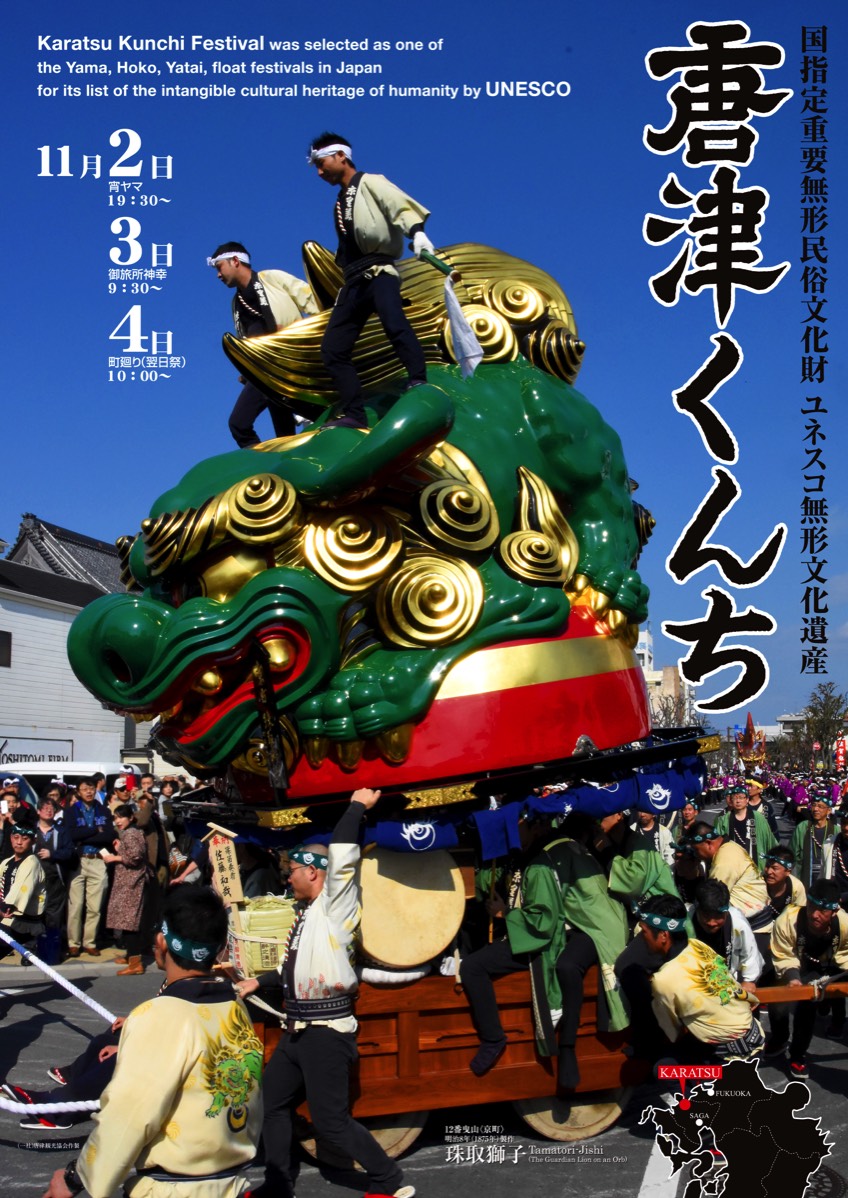During three days in November, the town of Karatsu turns its attention to the colorful and exciting pageantry of the annual festival. Starting with the beautiful lantern lit night parade on the 2nd until the rousing farewell on the 4th, the entire town of Karatsu pulsates with the sounds of flutes, drums and the chorus of “En-ya” and “Yoi-sa”!
Designated an Important Intangible Folk Cultural Property, this 400-year-old event uses huge majestic floats in the shape of everything from samurai helmets and ships of the gods, to a dragon and a drunken oni (ogre). The current floats date as far back as 1819 and are on permanent display at the Hikiyama Exhibition Hall located next to Karatsu Shrine.
Pulled by over 100 people of all ages to the rhythm of flutes and drums and chants, the floats navigate impossibly narrow streets on their path to pay homage to the various temples and shrines in the area. With visitors and spectators watching from the streetside and houses the floats progress down the route throwing salt before them to purify their trek.
Yo-yama, or the night parade (19:45-22:00), is perhaps the most beautiful with lanterns hanging from the floats casting eerily enchanting shadows.
The second day begins with the floats gathering and then departing from Karatsu Shrine (09:30) in a majestic display through the throngs of onlookers. The second day’s highlight is the Otabisho Shinko (12:00-15:00), a timed race pulling the floats through the sands of Nishinohama beach to be lined up for an afternoon respite with famous and often unexpected visitors. After a well deserved meal and drink, the parade continues to the respective districts ending around 16:00.
As the festival winds down on the third day (10:00-17:30), though voices are hoarse and bodies are aching, the enthusiasm of the participants and spectators is still palpable until the last float is pulled home.
Throughout the entire festival, food and drink stalls and boardwalk games can be found lining the streets. The sake and drinks flow freely and everywhere you look you can see a squid on a stick, mini cakes in the shape of Anpan Man or other popular children's characters, grilled meat on a stick, and just about anything else you can imagine. It’s one of the few times eating while walking is not frowned upon. One of the busiest sections of the town is Karatsu Shrine from which the parade begins and ends each day. There you can see people dressed in the various garb designating the float teams and kimonos mingling with tourists and all lining up to shake the bells and pray to the god of the shrine.
If you are lucky enough to befriend a local who lives in one of the float districts, you may find yourself being hustled off to their house for a home party. Many households save about two months salary to host home parties on the third and the fourth. Respite for the float pullers and comfort for the spectators; people talk and laugh, eat and drink and meet friends. For many Japanese living in Tokyo or some of the other major cities, Obon holiday in August is when they return home. For people from Karatsu-Okunchi is the time to come home. It is truly amazing to find the kind of hospitality and generosity on display during the festival.
So, please come by, walk around, eat, drink and let the sound of flutes, drums and chants lead you to your next adventure.
https://en.wikipedia.org/wiki/Karatsu_Kunchi https://en.japantravel.com/saga/karatsu-kunchi-festival/32010 http://jpninfo.com/66718
https://www.jnto.go.jp/eng/spot/festival/karatsukunchi.html
